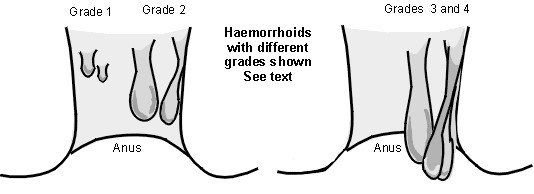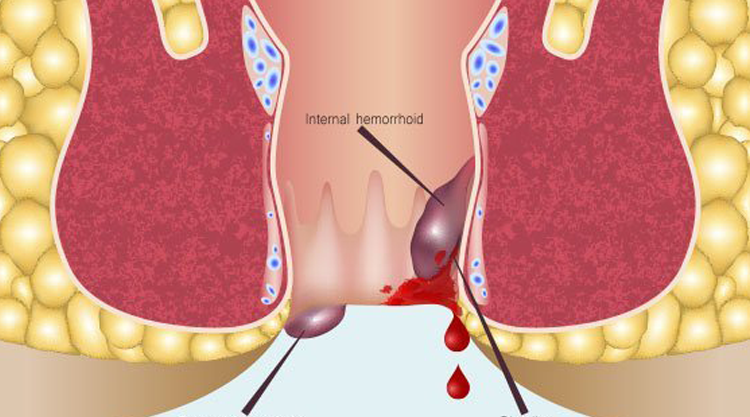Piles Surgery / Haemorrhoids
Piles are swellings that develop inside and around the back passage (anal canal). There is a network of small veins (blood vessels) within the lining of the anal canal. These veins sometimes become wider and engorged with more blood than usual. The engorged veins and the overlying tissue may then form into one or more swellings (piles). Piles often don't cause any problems but can cause bleeding and sometimes pain. If they do cause any bleeding or pain then you should see a doctor.
How many types of piles are there?
Piles can be divided into either internal or external piles. Some people develop internal and external piles at the same time.
- Internal piles are deeper and initially form above a point 2-3 cm inside the back passage (anal canal) in the upper part of the anal canal or lower rectum (the last part of the large bowel that connects to the anal canal).
- External piles start off nearer the surface, below a point 2-3 cm inside the back passage.
Despite the name, external piles aren't always seen outside of the opening of the back passage (anus). Equally confusing, internal piles can enlarge and drop down (prolapse), so that they hang outside of the anus.
Piles are also graded by their size and severity.
What are the symptoms of piles?
Piles symptoms can vary depending on the size, position and grade of the piles.
- Grade 1 are small swellings on the inside lining of the anal canal. They cannot be seen or felt from outside the opening of the back passage (anus). Grade 1 piles are common. In some people they enlarge further to grade 2 or more.
- Grade 2 are larger. They may be partly pushed out from the anus when you go to the toilet, but quickly spring back inside again.
- Grade 3 hang out from the anus when you go to the toilet. You may feel one or more as small, soft lumps that hang from the anus. However, you can push them back inside the anus with a finger.
- Grade 4 permanently hang down from within the anus, and you cannot push them back inside. They sometimes become quite large.

Sometimes there are no symptoms and may not realise that you have any piles.
The most common piles symptom is bleeding after going to the toilet to pass stools (faeces). The blood is usually bright red and may be noticed on the toilet tissue, in the toilet pan or coating the stools.
A pile can hang down (prolapse) and can be felt outside the back passage. Often, it can be pushed back up after you have been to the toilet. However, more severe piles remain permanently prolapsed and cannot be pushed back up inside.
Small internal piles are usually painless. Larger piles may cause a mucous discharge, some pain, irritation and itch. The discharge may irritate the skin around the anus. You may have a sense of fullness in the anus, or a feeling of not fully emptying your back passage when you go to the toilet.
What are possible complications of piles?
A possible complication of piles that hang down is that they can 'strangulate'. This means that the blood supply to the pile has been cut off. A blood clot (thrombosis) can form within the pile. This causes really severe pain if it occurs. The pain usually reaches a peak after 48-72 hours and then gradually goes away over 7-10 days.
About half of everyone in the UK develop one or more piles at some stage of their life.
The lining of the back passage (anal canal) contains many blood vessels (veins). There seem to be certain changes in the veins within the lining of the back passage that cause the pile(s) to develop. The lining of the back passage and the veins become much larger and this can then cause a swelling and develop into a pile.
However, we don't know exactly what causes a pile. Some piles seem to develop for no apparent reason. It is thought that there is an increased pressure in and around the opening of the back passage (anus). This is probably a major factor in causing haemorrhoids in many cases. If you delay going to the toilet and need to strain when on the toilet then this can increase the pressure and so makes it more likely that a pile will develop.
What makes piles more likely?
There are certain situations that increase the chance of piles developing:
- Constipation, passing large stools (faeces), and straining at the toilet. These increase the pressure in and around the veins in the anus and seem to be a common reason for piles to develop.
- Being overweight. This increases your risk of developing piles.
- Pregnancy. Piles are common during pregnancy. This is probably due to pressure effects of the baby lying above the rectum and anus, and also the affect that the change in hormones during pregnancy can have on the veins. Piles occurring during pregnancy often go away after the birth of the child.
- Ageing. The tissues in the lining of the anus may become less supportive as we become older.
- Hereditary factors. Some people may inherit a weakness of the wall of the veins in the anal region.
- Other possible causes of piles include heavy lifting or a persistent (chronic) cough.
Piles treatment
Various preparations and brands are commonly used for piles treatment. They do not cure piles. However, they may ease symptoms such as discomfort and itch.
Avoid constipation and straining at the toilet
Keep the stools (faeces) soft, and don't strain on the toilet. You can do this by:
- Eating plenty of fibre (for example, fruit, vegetables, cereals and wholegrain bread).
- Have lots to drink. Most sorts of drink will do but too much alcohol and caffeine should be avoided.
- Fibre supplements. If a high-fibre diet is not helping, you can take fibre supplements (bulking agents) such as ispaghula, methylcellulose, bran or sterculia.
- Avoid painkillers that contain codeine, such as co-codamol, as they are a common cause of constipation. However, simple painkillers such as paracetamol may help.
- Toileting. Go to the toilet as soon as possible after feeling the need. Do not strain on the toilet.
- Regular exercise helps to reduce constipation.
These measures will often ease piles symptoms such as bleeding and discomfort. It may be all that you need to treat small and non-prolapsing piles (grade 1). Small grade 1 piles often settle down over time.
See the separate leaflets called Constipation, Constipation in Children and Fibre and Fibre Supplements for more information.
Ointments, creams and suppositories
- A bland soothing cream, ointment, or suppository may ease discomfort.
- One that contains an anaesthetic may ease pain better. You should only use one of these for short periods at a time (5-7 days).
- Preparations which contain a corticosteroid for treating piles may be advised by a doctor if there is a lot of inflammation around the piles. This may help to ease itch and pain. You should not normally use a steroid cream or ointment for longer than one week at a time.
What are the surgical options for piles?
Haemorrhoidectomy (the traditional operation)
An operation to cut away the haemorrhoid(s) is an option to treat grade 3 or 4 piles or for piles not successfully treated by banding or other methods. The operation is done under general anaesthetic and is usually successful. However, it can be quite painful in the days following the operation.
Stapled haemorrhoidopexy
A circular stapling gun is used to cut out a circular section of the lining of the back passage (anal canal) above the piles. This has the effect of pulling the piles back up the back passage. It also has the effect of reducing the blood supply to the piles and so they shrink as a consequence. Because the cutting is actually above the piles, it is usually a less painful procedure than the traditional operation to remove the piles.
Haemorrhoidal artery ligation and Laser ablation of piles
The small arteries that supply blood to the piles are tied (ligated) and then a laser beam energy is fired at the pile mass. This causes the haemorrhoid(s) to shrink.
What about strangulated or thrombosed piles?
Strangulated or thrombosed piles are uncommon but usually very painful. Treatments usually include bed rest, medication for pain relief, hot baths, ice packs and keeping your stools (faeces) soft (see above). Surgery may, rarely, be needed to remove the haemorrhoid.
